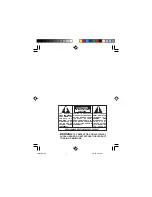
Minimum protection requires one alarm as close to the sleeping area as
possible. For better protection, put one alarm in each room, but first read the
Locations to Avoid.
LOCATIONS TO AVOID
Nuisance alarms are caused by placing alarms where they will not operate
properly.
To avoid nuisance alarms, do not place alarms:
·
In or near areas where combustion particles are normally present
such as kitchens; in garages
where there are particles of combustion
in vehicle exhausts;
near furnaces, hot water heaters, or gas space
heaters. Install alarms at least 20 feet (6 meters) away from kitch-
ens and other areas where combustion particles are normally
present.
·
In air streams passing by kitchens.
Figure 6 shows how an alarm
can be exposed to combustion particles in normal air movement paths,
and how to correct this situation.
WIRING/GENERAL
1. Use U.L. Listed cable with Class 1 insulation.
2. Observe local code requirements. Use box connector to anchor cable
to outlet box.
3. Metal outlet boxes must be grounded to earth ground.
CAUTION:
Turn off electricity to prevent SHOCK and damage to alarm.
Be sure the power line to the alarm is
not
controlled by any on/off switch, or
other type of switch, other than a fuse or circuit breaker.
IMPORTANT:
Insure that all fluorescent lighting fixtures are properly
grounded.
WARNING:
Alarm installation must conform to the electrical codes in your
area and to Article 760 of the U.S. National Electrical Code. Wire installa-
tion should be performed only by a licensed electrician.
MOUNTING OUTLET BOX
Use a 2 x 3 switch box or a 4 square or octagon junction box. Mount a
box for each alarm. If wall mounting is desired, be sure the box screws are
oriented to upper right and lower left corners. Be sure to use supplied
mounting plate.
NOTE
: For trouble areas where there can be a large volume of air blowing out
through the electrical junction box. You must first insert the cardboard shield
packaged with your smoke alarm to the backside of alarm before securing it to
mounting plate.
WIRING ONE ALARM
1.
Run a minimum of 16 gauge, 2-conductor cable, plus ground (3 wires)
to the alarm junction box from a power supply. Use U.L. Listed Class
1 wire.
2.
Make wire connections to the supplied plug-in connector as follows:
black to black, white to white, and connect the ground wire to the
metal outlet box.
Figure 6
·
In damp or very humid areas,
or next to bathrooms with showers.
The moisture in humid air can enter the sensing chamber as water
vapor, then cool and condense into droplets that cause a nuisance
alarm.
Install alarms at least 10 feet
(3 meters)
away from bath-
rooms.
·
In very cold or very hot environments, or in unheated buildings
or outdoor rooms,
where the temperature can go below or above the
operating range of the alarm. Temperature limits for proper operation
are 40
°
to 100
°
F (4.4
°
to 37.8
°
C).
·
In very dusty or dirty areas.
Dust and dirt can build up on the alarms
sensing chamber and can make it overly sensitive, or block openings to
the sensing chamber and keep the alarm from sensing smoke.
·
Near fresh air inlets or returns or excessively drafty areas.
Air con-
ditioners, heaters, fans, and fresh air intakes and returns can drive smoke
away from smoke alarms, making the alarms less effective.
·
In dead air spaces at the top of a peaked roof or in the corners
between ceilings and walls.
Dead air may prevent smoke from reach-
ing an alarm. See Figures 4 and 5 for recommended mounting loca-
tions.
·
In insect-infested areas.
If insects enter an alarms sensing chamber,
they may cause a nuisance alarm.
Get rid of the bugs before install-
ing alarms where bugs are a problem.
·
Near fluorescent light fixtures.
Electrical noise from nearby fluo-
rescent light fixtures may cause a nuisance alarm.
Install alarms at
least 5 feet
(1.5 meters)
away from such light fixtures.
WARNING:
Never disconnect power from an alarm to silence a nuisance
alarm. Open a window or fan the air around the alarm to remove the
smoke. The alarm will automatically turn off when the smoke in the air is
completely gone. Do not stand close to the alarm. The sound produced by
the alarm is loud because it is designed to awaken you in an emergency.
Prolonged exposure to the horn at a close distance may be harmful to your
hearing.
INSTALLATION
CAUTION:
New Construction: DO NOT attach alarm head until AFTER
sanding, insulation, painting, and other dust creating situations are finished
and cleaned up.
NOTE/RED-YELLOW WIRE: The red-yellow wire from the alarm is for
tandem connection only. DO NOT USE, AND DO NOT REMOVE INSULA-
TION CAP UNLESS CONNECTING ANOTHER ALARM.
WIRING TWO OR MORE ALARMS
Tandem Installation
CAUTION
: All alarms in a tandem installation must be controlled by the
same fuse or circuit breaker. Otherwise tandem units will not operate.
LIMITATIONS:
A maximum of 12 alarms (517T or 517TH) may be
connected together. Do not exceed 125 feet between each alarm. Do not
exceed 1125 feet between first and last alarm.
























